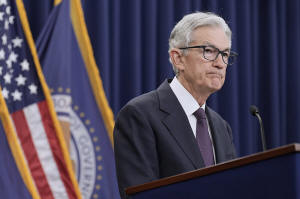Fed leaves key rate unchanged as it awaits the impact of tariffs and
Trump again scolds Powell
[June 19, 2025] By
CHRISTOPHER RUGABER
WASHINGTON (AP) — The Federal Reserve kept its key rate unchanged
Wednesday as it waits for additional information on how tariffs and
other potential disruptions will affect the economy this year.
The Fed's policymakers signaled they still expect to cut rates twice
this year, even as they also project that President Donald Trump's
import duties will push inflation higher. They also expect growth to
slow and unemployment to edge up, according to their latest quarterly
projections released Wednesday.
Fed policymakers had cut their rate three times late last year but have
since have been on hold. Inflation has cooled steadily since January,
but Fed Chair Jerome Powell said at a news conference that tariffs are
likely to reverse that progress and push inflation higher in the coming
months. The Fed expects the bump to inflation will be temporary, but
they want to see more data to be sure.
“Increases in tariffs this year are likely to push up prices and weigh
on economic activity," Powell said. "This is something we know is
coming, we just don’t know the size of it.”
Changes to the Fed's rate typically — though not always — influence
borrowing costs for mortgages, auto loans, credit cards, and business
loans.
So far inflation has continued to decline while some cracks have
appeared in the economy, particularly in housing, where elevated
borrowing costs are slowing sales and homebuilding. Hiring has also
slowed. Such trends would typically lead the Fed to reduce its key rate,
which is currently at about 4.3%.
Yet Powell said the economy remains in good shape and the Fed has to
consider the potential for prices to rise soon.

“You can see perhaps a very, very slow continued cooling” in the job
market, “but nothing that's troubling at this time,” he said.
“We have to be forward looking,” Powell said later. "We expect a
meaningful amount of inflation to arrive in coming months and we have to
take that into account.”
Powell also said the Fed will learn much more over the summer about how
tariffs will affect the economy. George Pearkes, global macro strategist
for Bespoke Investment Group, said he interpreted that to mean the Fed
won't cut until September, at the earliest. Its next meeting is in July.
“Unless we see a really, really rapid deterioration in the labor market
we won’t see a cut until September, and maybe not even then,” he said.
Wall Street investors currently expect the Fed to cut in September,
according to futures prices tracked by CME Fedwatch.
Fed officials see inflation, according to their preferred measure,
rising to 3% by the end of this year, from 2.1% in April, according to
the projections released Wednesday. They also project the unemployment
rate will rise to 4.5%, from 4.2% currently. Growth is expected to slow
to just 1.4% this year, down from 2.5% last year.
[to top of second column] |

Federal Reserve Board Chairman Jerome Powell speaks during a news
conference at the Federal Reserve in Washington, Wednesday, June 18,
2025. (AP Photo/Mark Schiefelbein)
 Claudia Sahm, chief economist at New
Century Advisors and a former Fed economist, said that the
projections show that policymakers do expect inflation to come down
in 2026 and 2027, with the tariffs having just a temporary impact.
Without the duties, officials would be more likely to cut rates
soon, she said.
“The Fed seems to be in agreement that this will be temporary, but
they don’t have high enough conviction yet," she said.
So far, inflation has cooled this year to just 2.1% in April,
essentially back at the central bank’s target of 2%. Core inflation,
which excludes the volatile food and energy categories, remains
elevated at 2.5%.
Trump has pointed to the mild inflation figures to argue that the
Fed should lower borrowing costs and has repeatedly criticized
Powell for not doing so. On Wednesday he called Powell “stupid” and
accused him of being “political” for not cutting rates.
“So we have no inflation, we have only success,” Trump said, before
the Fed announced its decision. “And I’d like to see interest rates
get down.”
Trump has previously argued that a rate cut would boost the economy.
Now his focus has shifted to the federal government’s borrowing
costs, which have shot higher since the pandemic, with interest
payments running at an annual rate of more than $1 trillion.
Pushing the Fed to cut rates simply to save the government on its
interest payments typically raises alarms among economists, because
it would threaten the Fed’s congressional mandate to focus on stable
prices and maximum employment.
One of Trump’s complaints is that the Fed isn’t cutting rates even
as other central banks around the world have reduced their borrowing
costs, including in Europe, Canada, and the U.K. On Tuesday, the
Bank of Japan kept its key short-term rate unchanged at 0.5%, after
actually raising it recently.
But the European Central Bank, Bank of Canada, and Bank of England
have reduced their rates this year in part because U.S. tariffs are
weakening their economies. So far the U.S. economy is mostly solid,
with the unemployment rate low.
The Bank of England has cut its rate twice this year but is expected
to keep it unchanged at 4.25% when it meets Thursday.
__
AP reporter Alex Veiga contributed.
All contents © copyright 2025 Associated Press. All rights reserved |